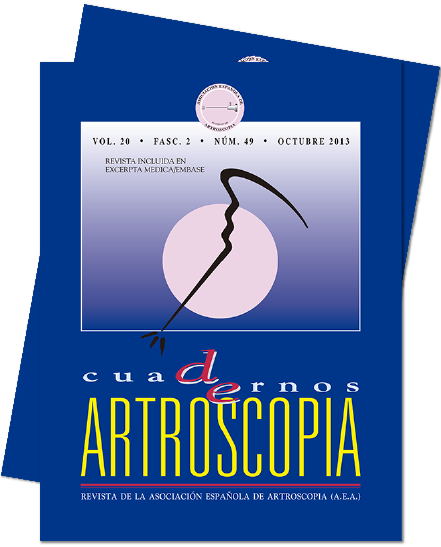Resumen:
La patología del tendón de la porción larga del bíceps (PLB) es una causa clara de dolor en la patología del manguito rotador; si bien, in vivo, su papel sigue siendo controvertido.
En roturas masivas del manguito rotador, pacientes con baja demanda funcional, ascenso de la cabeza humeral con disminución del intervalo acromio-humeral y pacientes no cumplidores con los programas de rehabilitación, la tenotomía artroscópica de la PLB puede ser el tratamiento de elección.
Se revisan 31 tenotomías realizadas en 29 pacientes con un seguimiento medio de 10,9 años (mínimo de 8,41 años). Se produjeron 10 pérdidas durante el seguimiento. Se ha realizado una valoración clínica, con la escala funcional del test de Constant preoperatorio y en el momento actual, y cuestionario de calidad de vida SF-36 en 19 pacientes (21 tenotomías) y, de ellos, una valoración radiológica del intervalo acromio-humeral y grado de artrosis según la clasificación de Hamada en 16 pacientes (17 tenotomías).
Existe una diferencia estadísticamente significativa (p < 0,0001) en los valores del test de Constant preoperatorio (35,58 puntos) y postoperatorio (63,11 puntos). Sin embargo, no existe una correlación significativa entre los valores del test de Constant y el intervalo acromiohumeral (p = 0,7425) ni con el grado de artrosis radiológica (p = 0,635). Los resultados son excelentes/buenos en el 52% de los pacientes, teniendo un mal resultado sólo en el 16%.
Abstract:
The long head of the biceps tendon lessions are a clear cause of pain in the rotator cuff pathology, even though its role in vivo is still controversial.
In massive ruptures of the rotator cuff, patients with low activity patterns, an elevated head of the humerus with a decrease of the acromio-humeral interval and patients not committed to the rehabilitations programs, the arthroscopic tenotomy of the long head of the biceps can be the best treatment.
Thirty one tenotomies performed in 29 patients have been reviewed, with an average follow up of 10.9 years (minimum of 8.41 years). A clinical evaluation using the Constant test has been performed before surgery and in the present moment, as well as the SF-36 questionnaire and a radiological evaluation of the acromio-humeral interval and the arthritis signs, following the Hamada classification.
There is a statistically significant difference (p < 0,0001) in the Constant test values preoperative (35,58 points) and postoperative (63,11 points). However, there is no significant correlation between the Constant test values and the acromio-humeral interval (p = 0,7425) or the arthritis radiological degree (p = 0,635). The results are excellent / good in 52% of the patients, with a bad result only in 16% of them.




